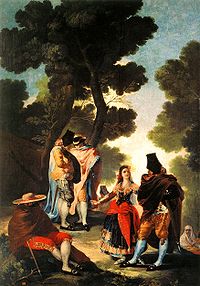
Majo
Encyclopedia

Madrid
Madrid is the capital and largest city of Spain. The population of the city is roughly 3.3 million and the entire population of the Madrid metropolitan area is calculated to be 6.271 million. It is the third largest city in the European Union, after London and Berlin, and its metropolitan...
, who distinguished themselves by their elaborate outfits and sense of style in dress and manners, as well as by their cheeky behavior.
They flourished from the late 18th to early 19th century, and to some extent later. Majos and majas were one of the favorite subjects of some 19th century Spanish painters.
The majos and majas outfits were exaggerations of traditional Spanish dress. The style stood in strong contrast to the French
France
The French Republic , The French Republic , The French Republic , (commonly known as France , is a unitary semi-presidential republic in Western Europe with several overseas territories and islands located on other continents and in the Indian, Pacific, and Atlantic oceans. Metropolitan France...
styles affected by many of the Spanish elite under the influence of the Enlightenment. Majos were known to pick fights with those they saw as afrancesados ("Frenchified").
In Spanish, the word possesses derived forms such as chulapo and chulapa, a version of chulo and chula in reference to their saucy attitude, as well as chispero and chispera, among others.
Popularity of the Maja
Although Majos of both sexes were frequent subjects of painter Francisco GoyaFrancisco Goya
Francisco José de Goya y Lucientes was a Spanish romantic painter and printmaker regarded both as the last of the Old Masters and the first of the moderns. Goya was a court painter to the Spanish Crown, and through his works was both a commentator on and chronicler of his era...
, two of his Majas, La maja vestida
La Maja Vestida
La maja vestida is a painting by Spanish painter Francisco de Goya between 1798 and 1805. It is a clothed version of La maja desnuda and is exhibited next to it in the same room at the Prado Museum in Madrid...
and La maja desnuda
La Maja Desnuda
La maja desnuda is an oil on canvas painting by the Spanish painter Francisco Goya , portraying a nude woman reclining on a bed of pillows. It was executed some time between 1797 and 1800, and is sometimes said to be the first clear depiction of female pubic hair in a large Western painting...
, would gain international renown.
The outfit of the Maja also would influence the costume of Carmen, the protagonist of Georges Bizet
Georges Bizet
Georges Bizet formally Alexandre César Léopold Bizet, was a French composer, mainly of operas. In a career cut short by his early death, he achieved few successes before his final work, Carmen, became one of the most popular and frequently performed works in the entire opera repertory.During a...
's French opera Carmen
Carmen
Carmen is a French opéra comique by Georges Bizet. The libretto is by Henri Meilhac and Ludovic Halévy, based on the novella of the same title by Prosper Mérimée, first published in 1845, itself possibly influenced by the narrative poem The Gypsies by Alexander Pushkin...
in mid 19th century.
In the 20th century, with the popularization of Spain as a tourist destination, the Manola or Maja increasingly gained recognition as the image of a stereotypical traditional Spanish woman. Thus the Maja became one of the popular and informal symbols of Spain, along with the bullfighter, who took the place of the Majo. Some of the 20th century depictions of the Maja became somewhat assimilated to the flamenco dancer (la bailaora). Nowadays, the increasing popularity of the Maja has ended up eclipsing that of the Majo.
The image of a Maja was the trademark of the Jabon Maja Myrurgia soap
Soap
In chemistry, soap is a salt of a fatty acid.IUPAC. "" Compendium of Chemical Terminology, 2nd ed. . Compiled by A. D. McNaught and A. Wilkinson. Blackwell Scientific Publications, Oxford . XML on-line corrected version: created by M. Nic, J. Jirat, B. Kosata; updates compiled by A. Jenkins. ISBN...
, one of the classical souvenirs from Spain. The brand's portrait of the Maja in the soap boxes and wrappings was based on the person of Carmen Tórtola Valencia (1882 - 1955), a famous Spanish dancer of the early 20th century.

